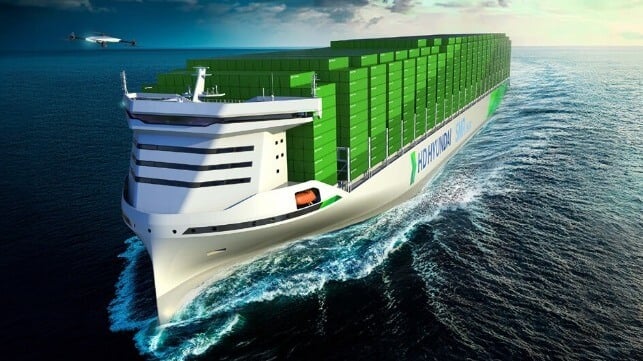HD Korea Shipbuilding Advances Designs for Large Nuclear-Powered Boxship

HD Hyundai’s HD Korea Shipbuilding & Offshore Engineering (KSOE) is advancing its efforts towards a large, nuclear-powered containership. The shipbuilding has been working on its project as one of several that believe the new generation of small nuclear reactors will be the solution to maritime decarbonization.
Interest in nuclear-powered propulsion for merchant ships dates back to the 1950s when it was seen to hold great promise. The United States was the first country to successfully build and operate a demonstration cargo-passenger ship, NS Savannah, which provided many insights into the industry but also showed the practical challenges of nuclear propulsion. Japan and Germany also tested concepts but Russia currently is the only country operating nuclear-powered commercial shipping with its icebreakers and one containership run by the state.
"Nuclear-powered vessels can be a game-changer in the current shipbuilding market, where carbon neutrality is emerging," said Patrick Ryan, Chief Technology Officer of ABS. The classification society has conducted studies for the U.S. on the future of nuclear propulsion. Ryan said, "ABS and HD KSOE will contribute to accelerating the commercialization of marine nuclear technology in the global shipbuilding market."
KSOE had proposed concepts and in 2024 obtained Approval in Principle from ABS for a design model applying Small Modular Reactor (SMR) technology. It is one of several concepts the industry is looking at for the next generation of nuclear-powered merchant ships.
"HD KSOE is strengthening cooperation not only with major classification societies but also with international regulatory bodies to establish international regulations necessary for the commercialization of nuclear-powered vessels," said Park Sangmin, Head of HD KSOE's Green Energy Research Lab. "Starting with the land-based SMR reactor manufacturing project, we aim to develop a marine nuclear business model by 2030."
Since February last year, HD KSOE has been accelerating related technology development through joint research on next-generation SMRs with TerraPower. In December, the company secured an order to manufacture the main equipment for TerraPower's Natrium reactor, which is being constructed in Wyoming.
In the maritime sector, KSOE unveiled an advanced design for a 15,000 TEU containership using SMR technology. The new design model features enhanced economic efficiency and safety by incorporating actual equipment and safety design concepts KSOE reports.
HD KSOE has also optimized the space previously occupied by large engine room equipment to accommodate additional containers, enhancing the economic efficiency of the design concept. The company has also applied a marine radiation shielding system using a double-tank method with stainless steel and a coolant based on light water to ensure safety. The shipbuilder announced that in collaboration with global energy technology company Baker Hughes, they have applied a supercritical carbon dioxide-based propulsion system, which would improve thermal efficiency by approximately five percent compared to existing steam-based propulsion systems.
HD KSOE plans to establish a marine nuclear demonstration facility at its Future Technology Test Center in Yongin, South Korea to verify safety designs.
The company is committed to advancing the design concepts. HD Hyundai’s business strategy for the shipbuilding operation focuses on advanced technologies, green shipping, and automation. Using this approach it looks to maintain leadership in the high-value vessel segment of the shipbuilding market.
